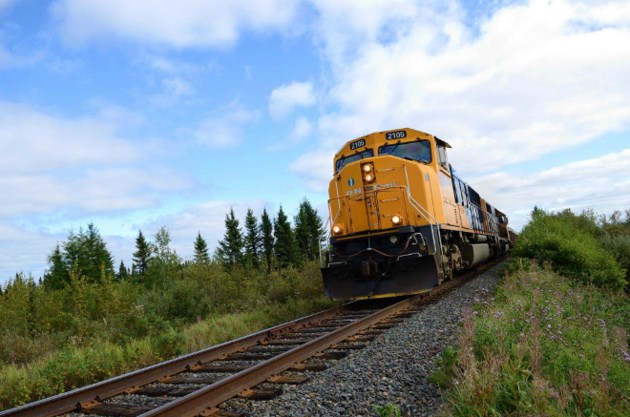Are the Chinese still railing for the ring?
posted on
Sep 07, 2017 08:34AM

Black Horse deposit has an Inferred Resource Now 85.9 Million Tonnes @ 34.5%

Perhaps a mining minute on the progress with the Chinese if there still is any?
==========================================
Stan Sudol @SudolStan 2m2 minutes ago
http://bit.ly/2xS9PGC Ontario Northland should be responsible for any future rail development into the Ring of Fire - not the Chinese!

The Ontario Northland Railway (ONR) is ready to be a logistical player in the Ring of Fire, if and when an ore haul railroad is required.
Now that Queen’s Park has unveiled a road-building timetable to reach the Far North mineral deposits, Ontario Northland Transportation Commission president-CEO Corina Moore said the North Bay-headquartered Crown railroader has the ability to do the job.
“Ontario Northland remains interested in providing input on how we can provide rail support in the future with regards to the Ring of Fire,” said Moore in an email.
She was responding to comments made by Noront Resources president-CEO Alan Coutts, who hinted that the ONR could serve as the exclusive railroader to the Ring.
“When the Ring of Fire chromite market grows to a level requiring rail, Ontario Northland has the experience, technology, and capabilities to safely operate and maintain the rail infrastructure,” replied Moore.
She said the commission has on occasion “highlighted our capabilities” to Noront, the Timmins Economic Development Corporation (EDC), and organizations that may be involved in mine-related development.
“To me, that makes a lot of sense,” said Coutts, who added his company has been in discussion with the ONR, a provincial agency supported through the Ministry of Northern Development and Mines.
“If you’re going to think about how you develop that corridor 20 years from now, maybe that’s the way to go.”
Building a north-south corridor would certainly be the most capital intensive and environmentally risky route since there are major rivers to cross.
“I’ve talked to them quite a little bit,” said Coutts.
“I’ve talked to Corina Moore and her team and they’re very interested in the long-term planning horizon. They know that there’s no railway required any time soon. They’re thinking longer term and what do (those plans) look like?”
In August, the province announced technical and environmental work had started on a two-road network to reach the Ring of Fire and enable year-round accessibility to nearby First Nation communities. Construction starts sometime in 2019, pending a myriad of approvals including consent from area First Nations.
A proposed east-west community/industry road would extend from Pickle Lake into the Ring, while the first leg of a north-south road would begin near Nakina and track north to Marten Falls First Nation.
The north-south corridor has often been mentioned as the preferred route and most solid ground for a railway.
KWG Resources, another Ring of Fire chromite player and staunch railroad promoter, took its Chinese railway engineering partners to meet with Ontario Northland officials in April 2016.
But Coutts is skeptical whether rail will be needed anytime soon, saying it depends on the eventual scale of the mining operations and the tonnages hauled out.
“In order to make a railway really viable and necessary, you need to be moving somewhere in the order of 8-10 million tonnes (of chromite) per annum.
The market just won’t support that at this point in time, even with a large-scale project,” Coutts said, mentioning that Cliffs Natural Resources only proposed moving 3-4 million tonnes at one time.
Noront is only talking about mining 500,000 tonnes of chromite from its Blackbird project before opening the lids on its larger deposits.
According to its project sequence, Noront’s Eagle’s Nest nickel-copper project would be their first mine developed over the next five years, followed by Blackbird.
The mine concentrate would be trucked to a railhead in northwestern Ontario and sent away for processing. Sudbury will get the nickel from Eagle’s Nest while the Blackbird chromite will be processed at a yet-to-be-named ferrochrome furnace site.
Sault Ste. Marie, Sudbury, Timmins and Thunder Bay-Fort William First Nation are vying to be the host community.
Coutts said the ONR has also weighed in on the City of Timmins’ proposal to have chromite processed at the former Kidd Metallurgical Site.
“They said maybe they’ll play a role in getting the ore from the railhead to Timmins. We’ve talked to them on a few levels.”
Moore replied that they’ve provided information to the Timmins EDC since they already provide rail service to the Met Site.
“This opportunity would significantly benefit both the City of Timmins and Ontario Northland.”
The ONTC has rail operations from North Bay to Calstock (37 kilometres west of Hearst) with three spur lines, including one into Timmins and from Cochrane to Moosonee on the James Bay coast.
Processing the chromite in Timmins would certainly improve the ONTC’s bottom line.
The ONTC has been seeking to boost freight opportunities since the closure of the Met Site in 2010 and a subsequent decline in forest products traffic.
There would be outbound mineral products from the Ring of Fire and inbound machinery, chemicals, and supplies.
But it would require millions in investment, beginning upfront with laying track between Calstock and Nakina. CN Rail abandoned the Calstock-Nakina track – the former Pagwa subdivision – in the 1980s, a distance of 117.6 miles. The ONTC acquired 22 miles of that track in 1990 to service the Lecours sawmill in Calstock.